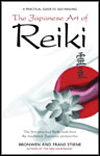Symbols and mantras are one of the five main elements of the system of Reiki. Below is an excerpt from The Japanese Art of Reiki.
The Japanese names for mantras and symbols are as follows:
Kototama – mantras
Shirushi – symbols
Description
When one practices the system of Reiki and moves from the first to the second level, three symbols and mantras are taught. At the third level yet another symbol and mantra are taught. Thus, in total, there are four mantras and symbols taught in the system of Reiki. Naturally, as practitioners progress through the system’s three levels new information is taught at each phase. New information is not necessarily secret but it also I is not shared until a practitioner has reached an appropriate level of understanding. This is the case with the symbols and mantras.
Basic rudiments of the system of Reiki are taught at the first level: experience with Ki work using the precepts, kokyû techniques and tenohira. Practical knowledge of these must first be gained before progressing further. With a practitioner’s discipline and routine in place an environment is cultivated that extends and deepens basic knowledge of the system. Kototama and Shirushi are two tools that are used to support this objective.
To aid a practitioner’s self-practice within the system; The Japanese Art of Reiki uses the symbols and mantras to help you to have a direct experience of your true nature. The names of the mantras and the drawn symbols will not be included here. Pseudonyms have been incorporated to replace the true mantras; these aliases are CKR, SHK, HSZSN and DKM. This book does not pretend to replace a teacher or to take a practitioner through the different levels of learning – this can only occur experientially under guidance. It is instead a support and further education for those who have received the system’s teachings or are interested in doing so. Do not feel left out if you have not studied any specific level of the system as this chapter will be a valuable asset to everyone. It offers a captivating insight into where your self-practice may lead in the future.
These tools, the kototama and shirushi, are used to invoke a specific energy. Though dissimilar tools, they share this chapter as they work toward an identical aim. By using these tools you connect to certain aspects of yourself (for example Earth and Heaven Ki) and with constant practice this will awaken inner dormant energy. The realization and consciousness that these practices bring helps us to regain our full human potential. Therefore, it is not on the outside but on the inside that one should be concentrating to delve to unlimited depths. Furthermore, as one’s experience develops the actual need for these tools diminishes and their energies are called upon without effort.
Source
Kototama
The Japanese name for mantra, kototama, means ‘sound which invokes a very specific cosmic vibration’. Occasionally the mantras used in the system of Reiki have also been called ‘kotodama’, which means ‘words carrying spirit’ – clearly Shinto concepts. In ancient times, not only did the Japanese believe that the gods or kami were in every object and natural element, but in words too. They believed that each word uttered had the mysterious power to come true: influencing the fortunes, or misfortunes, of those who spoke and received them. The inclusion of mantras in the system of Reiki made the teachings easily accessible to Shinto practitioners.
Shirushi
It appears that Usui initially taught an early version of the mantras to students in the 1910s with the symbols being introduced a number of years later around 1923. Both were provided to act as training wheels, which practitioners could then discard once they had ‘become’ the appropriate energy. It would depend on a practitioner’s current abilities as to which tool would be given. The symbols were provided mainly to support those who had no past energetic training – such as the naval officers to whom Usui taught a form of Ki ‘first aid’.

